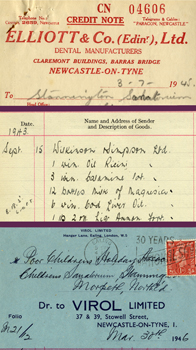|
Medical Care on the Wards
Records of the medical supplies bought in by the sanatorium give us a good idea of the nature of the day to day treatment on the wards. A whole host of medicines were clearly procured for their nutritional benefit to complement the children's diet and guarantee that they received the right amount of all necessary vitamins, for example beflavit tablets (vitamin B2), vitamin C tablets, Ostelin liquid (vitamin D), and Adexolin capsules (vitamin A). Other common medicines include cod liver oil, Numol, which was produced by a Newcastle based company and marketed as a tonic, nervine, and digestive, and Virol, a malt extract often given to children in the 1940s and 1950s.
Other medicines hint at the problems arising from the disease itself and the treatments offered. Many children, particularly those with TB of the bones and joints, would have been bed-bound as a common method of treatment was to immobilise the affected area by utilising plaster casts and splints, and so bed sores or skin ulcers and abscesses caused by underlying disease in the bone would have been a major problem. Potassium permanganate, calamine lotion, and Halibut Ointment are just three examples of the medicines bought in to tackle the problem, with the latter commonly used to treat eczema, surgical wounds, and prevent suppuration in bed-ridden patients.
Stannington was also made use of a host of other supplies including sputum bottles, surgical silk, a haemoglobinometer, and a sphygmomanometer for monitoring blood pressure. Various dressings and bandages were also in use, such as jelonet dressings which were used on ulcers, burns, and skin grafts and contained paraffin to prevent it adhering to the wound.
Penicillin is the one drug that is being purchased regularly by the mid-1940s to treat active infections. However, penicillin was not effective in the treatment of TB and the first effective TB antibiotic, streptomycin, did not come into use in Stannington until 1947.
|
|


|